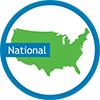State of the States July 14, 2023

Insurers report that the workers’ compensation line remains “favorable and predictable”
 National Council on Compensation Insurance (NCCI) researchers see the workers’ compensation line as remaining “favorable and predictable.” While factors such as medical inflation, an aging workforce, long covid, and economic uncertainty are present, these issues are likely to be offset by a “friendly claims environment” with low injury frequency and improved safety measures. 2023 will be the ninth year in a row for line profitability per NCCI. Senior officials with NCCI say that overall, the industry remains "cautiously optimistic" moving forward.
National Council on Compensation Insurance (NCCI) researchers see the workers’ compensation line as remaining “favorable and predictable.” While factors such as medical inflation, an aging workforce, long covid, and economic uncertainty are present, these issues are likely to be offset by a “friendly claims environment” with low injury frequency and improved safety measures. 2023 will be the ninth year in a row for line profitability per NCCI. Senior officials with NCCI say that overall, the industry remains "cautiously optimistic" moving forward.
The Division of Workers’ Compensation will hold an industry stakeholder meeting on dispute resolution rules later this month
![]() Rule 9 regarding dispute resolution will be discussed at the Division of Workers’ Compensation’s stakeholder meeting set for July 24th at 4:30 PM MT. Agency officials are reaching out to industry stakeholders for comment before undergoing formal rulemaking.
Rule 9 regarding dispute resolution will be discussed at the Division of Workers’ Compensation’s stakeholder meeting set for July 24th at 4:30 PM MT. Agency officials are reaching out to industry stakeholders for comment before undergoing formal rulemaking.
Regulators from the state Board of Pharmacy seek to finalize proposed prescription drug delivery rules
![]() The state Board of Pharmacy will discuss finalizing its rule regarding prescription drug delivery at its regularly scheduled meeting on August 16th. New language proposed by the Board would “ prohibit the delivery of drugs to a patient's residence where such drugs are intended to be later transported to another location for administration and that require special storage, reconstitution or compounding.” Comments on this topic were due by July 6th.
The state Board of Pharmacy will discuss finalizing its rule regarding prescription drug delivery at its regularly scheduled meeting on August 16th. New language proposed by the Board would “ prohibit the delivery of drugs to a patient's residence where such drugs are intended to be later transported to another location for administration and that require special storage, reconstitution or compounding.” Comments on this topic were due by July 6th.
Legislation went into effect on July 1 requiring that pharmacies make their drug labels accessible to patients with visual difficulties
![]() HB218 became effective on July 1st after being approved by Governor Green in May. The legislation is intended to help assist those with visual difficulties regarding their prescription care. Bill language necessitates that all dispensing pharmacies “make sustained, periodic, and reasonable efforts to inform the public that prescription drug label information is available in accessible formats for those who have difficulty seeing or reading standard printer labels on prescription drug containers.” The requirement would not be mandated for sole proprietorships with two pharmacists or less.
HB218 became effective on July 1st after being approved by Governor Green in May. The legislation is intended to help assist those with visual difficulties regarding their prescription care. Bill language necessitates that all dispensing pharmacies “make sustained, periodic, and reasonable efforts to inform the public that prescription drug label information is available in accessible formats for those who have difficulty seeing or reading standard printer labels on prescription drug containers.” The requirement would not be mandated for sole proprietorships with two pharmacists or less.
The state Department of Labor posted a notice this week regarding determination of average wholesale price (AWP)
![]() The state Department of Labor issued a notice reminding stakeholders that the state agency utilizes the Merative Micromedex Red Book when determining the average wholesale price of prescription drugs.
The state Department of Labor issued a notice reminding stakeholders that the state agency utilizes the Merative Micromedex Red Book when determining the average wholesale price of prescription drugs.
Department of Labor & Workforce Development personnel announced changes to its medical payment rules
![]() Officials from the Department of Labor and Workforce Development (DOLWD) proposed amending rules for medical payments. While most changes were grammatical, the DOLWD clarified compensation for missed medical appointments and independent medical examinations (IME). Agency personnel also altered language regarding reimbursement when a code is not listed in the rate tables, stating that “reimbursement of 100% of the Medicare rate if a code is not listed in the rate tables, or the methodology is not set forth in the medical payment rules.” Changes are set to take effect on September 25th.
Officials from the Department of Labor and Workforce Development (DOLWD) proposed amending rules for medical payments. While most changes were grammatical, the DOLWD clarified compensation for missed medical appointments and independent medical examinations (IME). Agency personnel also altered language regarding reimbursement when a code is not listed in the rate tables, stating that “reimbursement of 100% of the Medicare rate if a code is not listed in the rate tables, or the methodology is not set forth in the medical payment rules.” Changes are set to take effect on September 25th.
Findings from the Division of Workers’ Compensation show a high coverage rate for workers in the Lone Star state
![]() The Division of Workers’ Compensation announced the highest coverage rate for workers in over a decade. Although the Lone (Star) state does not require workers’ compensation insurance for employers, agency data indicates that more than 4 of 5 private sector employees were covered in 2022. Since 2018 the employer subscription rate increased 3 percent, from 72 percent in 2018 to 75 percent in 2022. The most common reason for subscribers purchasing coverage, according to the DWC’s report, is that employers would be able to provide medical care through a workers’ compensation healthcare network. More employers are purchasing coverage due to decreased costs, according to the DWC, noting that premium expenditures continue to drop by 78 percent+ since 2003. According to agency figures, the current average cost to insure is approximately 51 cents per $100 of payroll. For the 25 percent of private sector employees not covered under workers’ compensation, those entities cited high premiums, not enough employees, few work injuries, pandemic cost cuts, and that workers’ compensation is not required under state law as primary reasons not to insure.
The Division of Workers’ Compensation announced the highest coverage rate for workers in over a decade. Although the Lone (Star) state does not require workers’ compensation insurance for employers, agency data indicates that more than 4 of 5 private sector employees were covered in 2022. Since 2018 the employer subscription rate increased 3 percent, from 72 percent in 2018 to 75 percent in 2022. The most common reason for subscribers purchasing coverage, according to the DWC’s report, is that employers would be able to provide medical care through a workers’ compensation healthcare network. More employers are purchasing coverage due to decreased costs, according to the DWC, noting that premium expenditures continue to drop by 78 percent+ since 2003. According to agency figures, the current average cost to insure is approximately 51 cents per $100 of payroll. For the 25 percent of private sector employees not covered under workers’ compensation, those entities cited high premiums, not enough employees, few work injuries, pandemic cost cuts, and that workers’ compensation is not required under state law as primary reasons not to insure.
Note: To access audio for the LWU please access audio via Adobe by a.) choosing “view” at the top menu b.) click “activate read out loud” c.) click “read to end of the document”.
Stay connected to all relevant information in workers' compensation and pharmacy by subscribing to our weekly newsletter. For last week's wrap-up, please click here.
Other Posts You Might Be Interested In
Subscribe to email updates
Stay up-to-date on what's happening at this blog and get additional content about the benefits of subscribing.


